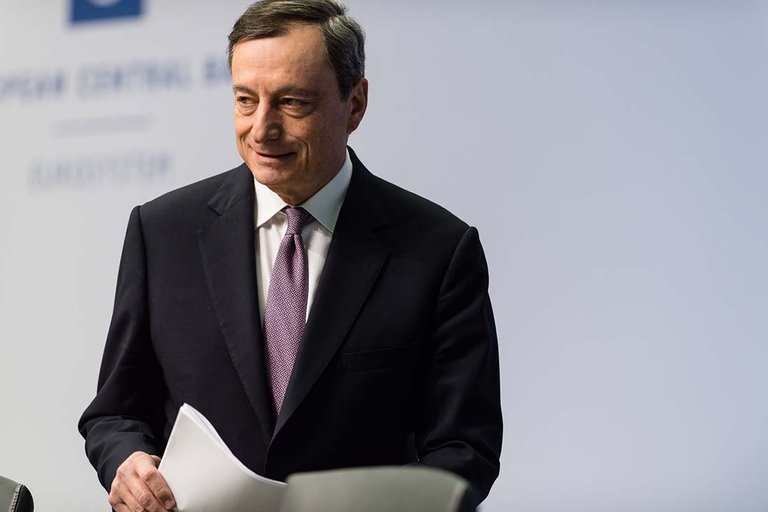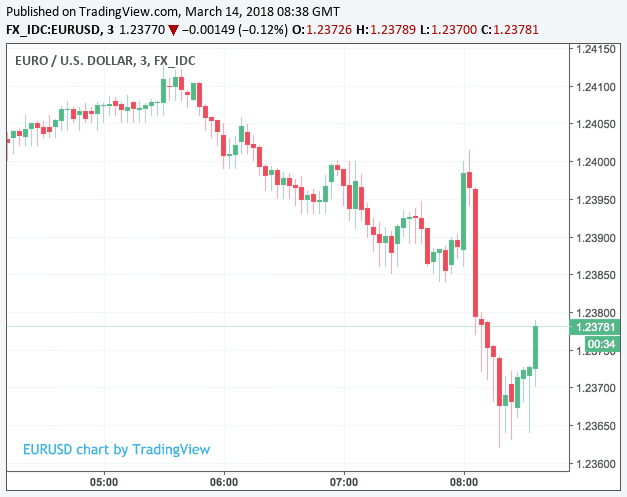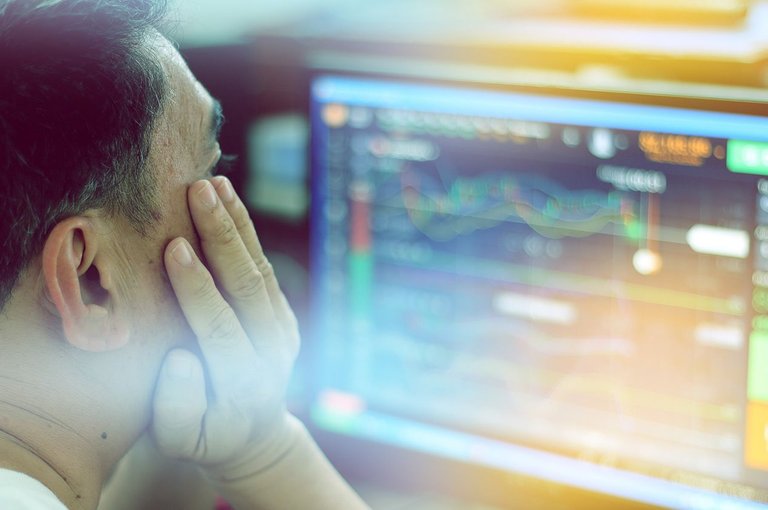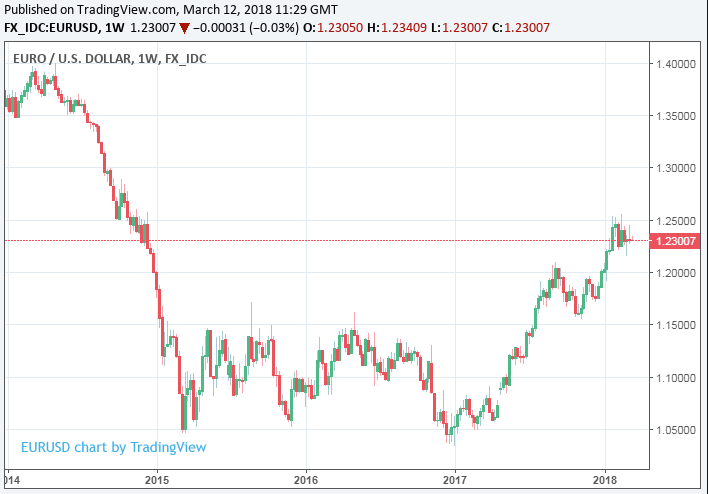The Euro dipped during mid-week trade when European Central Bank president Mario Draghi confirmed he was in no rush to change policy, providing further frustration for Euro bulls.
Data:
What is the Euro to Dollar Rate Today?
The live EUR/USD exchange rate is 1.2381
Change on Previous Day's Close +0.0525%
How does Today's Dollar Rate Compare with Previous Rates?
Today's opening exchange rate is 1.2373
Today's lowest exchange rate is 1.2371
Today's best exchange rate is 1.238
Best exchange rate of the year-to-date is 1.2555 (17-02-2018)
The lowest exchange rate of the year-to-date is
 Euro Struggles as Draghi Doubles-Down on Call for Gradual End to Q.E
Euro Struggles as Draghi Doubles-Down on Call for Gradual End to Q.E
Mid-week sees Draghi and other key ECB policy-setters appear at the The ECB and Its Watchers XIX Conference and currency traders will be looking for fresh clues as to future monetary policy.
Draghi delivered the opening address and ECB Chief Economist Praet and Vice-President Constancio will also appear later on in the day.
In short, Draghi notes:
- Eurozone Inflation is on track to move higher in line with expectations
- Asset purchases (quantitative easing) remains necessary
- Inflation adjustment would end quantitative easing
- Markets must be patient on policy
There is nothing there for the Euro to move higher on, in fact its quite the opposite. The reaction by the Euro was notable, with the Euro-to-Dollar exchange rate dipping on the release of Draghi's speech:

The Euro has been bid higher against a host of major currencies over recent months in anticipation of the ECB ending its quantitative easing programme and gearing up for interest rate rises.
However, the March policy meeting held last week and today's comments at the "watchers" conference confirm there is not going to be a rush to the exit, thereby depriving the Euro of fuel to rise higher.
Draghi's assessment of the economy in his speech was indeed positive and it is certainly headed in the right direction and he credit's the ECB's actions with much of the improvement:
"Our non-standard monetary policy measures have had a decisive influence on credit aggregates, as well as on bank-based transmission more broadly. We estimate that the growth rate of bank lending to euro area firms would be roughly half as strong today without our measures. Bank lending rates to firms would be almost 50% higher."
And it's because the ECB is doing so much heavy lifting that policy makers are understandably coy to withdraw their multi-billion Euro stimulus.
Of note, Draghi is confident employment in the Eurozone will continue to grow at a strong pace, but is cautious that there would not necessarily be the resultant rise in wages that would typically be expected to occur when it the labour pool diminishes under such conditions.
The ECB President notes labour market dynamics in the Eurozone are changing with three-quarters of employment growth over the recovery has come from older workers and more than half from women; something that was not seen in previous recoveries.
"This is in part because past labour market reforms have encouraged both groups to enter the workforce in response to higher growth. If substantially more workers can be drawn into the labour force, it would be possible for the labour market to strengthen further without generating wage pressures," says Draghi.
"In this environment, policymakers have to be more cautious than in the past about the assumptions that underpin our forecasts – and simple policy rules based around estimates of the output gap are no longer a useful guide for our actions," adds Draghi.
The equation for currency markets on the above is this: If wage pressures are to remain subdued then upward pressures on inflation will remain subdued = no need to end quantitative easing and push up rates = no boost for the Euro.
The ECB President also questioned how quickly the Eurozone's wage growth can feed through into inflation, saying recent wage growth "might be temporary" and "to build confidence that inflation dynamics are on track, we will need to see the actual data improving over time, which means stronger evidence of both strengthening wage growth and wage growth translating into ULC growth."
Draghi warned the ECB will therefore maintain the sequencing that is currently set out in our forward guidance, i.e. the pledge to keep key interest rates at their current levels “well past” the end of net purchases.
"But we still need to see further evidence that inflation dynamics are moving in the right direction. So monetary policy will remain patient, persistent and prudent," says Draghi.
The ECB President also added that the Euro's strength could weigh on inflation, which implies that the further the euro rises, the less inclined the ECB will be to end its quantitative easing programme.
Advertisement
Get up to 5% more foreign exchange by using a specialist provider to get closer to the real market rate and avoid the gaping spreads charged by your bank when providing currency. Learn more here.
The Euro "Primed" to Sell
![exchange-rates-9.jpg]
( )
)
“To us, the EUR looks ripe for consolidation versus the USD and looks primed to sell off on the crosses for several reasons” - CIBC Capital Markets.
The Euro is likely to trade with a downward bias against the Dollar and other currencies during coming days argue a number of foreign currency strategists we follow amidst signs of waning upward momentum and a litany of risks to sentiment.
First and foremost among those risks is the spectre of a possible trade war that has loomed large over European industry ever since President Donald Trump announced tariffs on the imports of aluminium and steel into the US, drawing threats of retaliation from the European Commission.
“While the introduction of tariffs has been messy and the threat of a trade war percolates, we think this puts surplus currencies in the crosshairs and in particular, the EUR,” says Mazen Issa, an FX strategist at TD Securities. “While the Trump administration has adopted a shoot-from-the-hip trade strategy, it has at least, provided a 15-day window for other countries to lobby a petition to be excluded from tariffs.”
European Commission threats of retaliation against the White House drew a stern response late last week when President Trump wrote on Twitter that any such response would merely beget more tariffs on other products.
“Until that comes to fruition however, we suspect that EURUSD and EUR/crosses will trade with a downward lean especially as we head into this week's ECB and It's Watchers Conference where we expect a confluence of ECB [governing council] members to reiterate some caution on policy,” Issa says, referring to the possibility that Europe may be able to dodge the new tariffs using the 15 day appeal window.
“We would look for EURUSD to respect the broad 1.2150/1.2550 range.”
The US president singled out Europe’s automotive sector as his next target on Twitter last week, which is notable because European carmakers have significant operations in North America. However, while the US is their largest market outside of the old continent, it is unclear how tariffs would impact European auto manufacturers.
After all, Europe’s car firms have spent billions developing manufacturing plants in Mexico during recent years and, given the ongoing renegotiation of the North American Free Trade Agreement, Mexico has been exempted from the new tariffs unveiled so far.

 “Outside of the crisis, we’d have to go back to 2003-2004. This type of long-term price action is atypical and if you’re playing the percentages, it makes sense to start thinking about taking some long EUR/USD risk off. Also, consider the post-ECB press conference last Thursday. Two things stuck out to us about Draghi when he spoke,” Rai notes.
“Outside of the crisis, we’d have to go back to 2003-2004. This type of long-term price action is atypical and if you’re playing the percentages, it makes sense to start thinking about taking some long EUR/USD risk off. Also, consider the post-ECB press conference last Thursday. Two things stuck out to us about Draghi when he spoke,” Rai notes.
Rai and the CIBC team flag the emphasis placed by European Central Bank chief Mario Draghi on how the Euro’s strength is becoming a risk to the bank’s attainment of its inflation target during last Thursday’s policy event as grounds for caution on the Euro. In addition, Draghi’s repeated emphasis that it will be some time before it fully normalises monetary policy also caught their attention.
“Taken together, it’s clear that the Bank is becoming more hawkish on currency gains. Further ECB guidance will be driven by the announcement of the QE end date and the reference to rates being low ‘well past the horizon of net asset purchases’. There’s no reason to change any of that for now and therefore all the more reason for EUR/USD to consolidate, and even trade defensively,” Rai concludes.
The ECB had been buying €60 billion or more of government and corporate bonds each month ever since the beginning of 2015 as part of a process known as quantitative easing, until it halved its purchases back in January.
Markets are now waiting for it to shutter the bond buying program completely, which would enable both European bond yields and the Euro to rise, although this isn’t expected to happen until at least September 2018.
Quantitative easing is designed to lift inflation by spurring economic activity, enabling the central bank to meet its obligation to ensure inflation remains close to, but below, the 2% target. It does this by forcing down bond yields, which is thought to reduce the cost of borrowing for companies and consumers in the real economy.
“The recent rally in the EUR has taken place on substantively lesser volume, while conversely the Dollar’s fallen on lesser volume. That was itself enough to get us bearish but add to that the confusion stemming from the Italian election and add further just the “talk” of tighter monetary policies but not real action of doing so in Europe...and we have both a fundamental and technical case to sell the EUR,” says Dennis Gartman, publisher of The Gartman Letter.
“We sold two units of the EUR upon receipt of this commentary at or near to 1.2390, looking for the EUR to make its way back toward 1.12-1.13. We’ll not want to see the EUR trade upward through 1.2535 on a closing basis here in North America.”
The Euro-to-Dollar rate was quoted 0.13% higher at 1.2319 during noon trading in London Monday.
Advertisement
Get up to 5% more foreign exchange by using a specialist provider to get closer to the real market rate and avoid the gaping spreads charged by your bank when providing currency.
Euro-to-Dollar Rate a “Buy on Dips” as Strong Growth Matters More than the ECB says Deutsche Bank
![exchange-rates-5.jpg]
( )
)
“An analysis of the flows driving the euro higher last year points to these being largely beyond the ECB’s control. First, there is Foreign Direct Investment (FDI) flows...Then we have equity flows.” - Deutsche Bank
Hi! I am a robot. I just upvoted you! I found similar content that readers might be interested in:
https://priceshall.com/currencies/euro/115851/euro-forecast-to-trade-on-the-defensive-this-week-as-risks-pile-up/